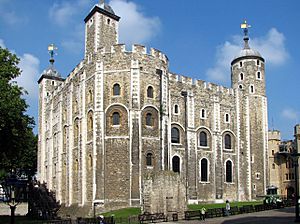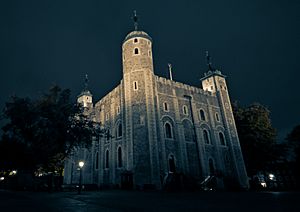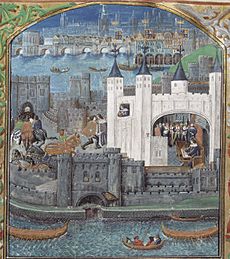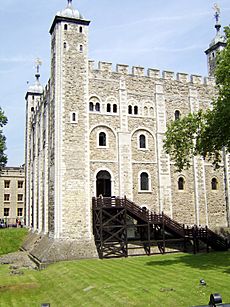White Tower (Tower of London) facts for kids
The White Tower is a very old and important building at the Tower of London. It's like the main tower or "keep" of the castle. William the Conqueror started building it way back in the 1080s. The White Tower was the strongest part of the castle for defense. It also had rooms for the king and his important guests, plus a special chapel. Later, in 1240, King Henry III ordered the tower to be painted white.
Contents
History of the White Tower
The Tower of London, where the White Tower stands, was started by William the Conqueror in 1066. At first, it was a wooden fort. Then, work began on the White Tower, a huge stone building that still stands tall today. We don't know the exact date construction started, but many believe it was in 1078. Gundulf, a bishop from Rochester, helped oversee the building work for William the Conqueror. The White Tower was one of the biggest keeps in the Christian world at that time.
The White Tower had many uses. It was the strongest military point of the castle. It also had fancy rooms for the king and his officials. A "keep" like this showed how powerful a lord was in Norman architecture. The White Tower was likely finished by 1100. Around the 1100s, a small building was added to protect the entrance, but it's gone now.
King Henry III had some disagreements with his nobles. So, in the 1220s and 1230s, he made the castle's defenses stronger. He added a wooden walkway called a "brattice" to the top of the White Tower. This helped soldiers defend the base of the tower better. Henry also started the tradition of painting the White Tower white. In 1240, he ordered it to be "whitened both inside and out." He may have wanted it to look grand, like other important buildings in Europe. He also added beautiful decorations to the chapel inside, like stained glass and paintings.
In the early 1300s, the castle was used less as a home for the king. The chapel in the White Tower even became a place to store important government papers. This showed that the castle was becoming less of a royal residence. In 1360, the papers were moved out for a short time to make room for the captured French king, John II. During the time of King Edward III (1327–1377), a storage building was added next to the White Tower. This showed the Tower's growing role as a place to keep military supplies.
King Richard II was held prisoner at the Tower of London in 1399. It's said that he gave up his crown there, possibly in the White Tower. In the 1490s, a new floor was added to the White Tower to create more storage space.
The Mystery of the Princes in the Tower
A sad and famous story connected to the White Tower is about the Princes in the Tower. In 1674, during some demolition work, bones of two children were found under the stairs of the old entrance building. Many believed these were the bones of the young princes.
After King Edward IV died, his 12-year-old son was supposed to become King Edward V. But he was never crowned. His uncle, Richard Duke of Gloucester, was made the person in charge while the prince was too young. Edward and his younger brother, Richard of Shrewsbury, were kept at the Tower of London. Then, their uncle Richard was declared King Richard III in July 1483. The princes were last seen in public in June 1483. Most historians believe they disappeared because they were killed later that summer. Their remains were later buried in Westminster Abbey.
Changes for Cannons and Storage
By the time of the Tudor period, castles needed to change to fight against powerful cannons. The Tower of London didn't get new, low-angled defenses. However, some changes were made to use cannons. A wooden platform was added to the top of the White Tower for cannons. The weight of these guns damaged the roof, so it had to be made stronger. These cannons were only used once, during a rebellion in 1554, and they didn't work very well.
The offices in charge of weapons and armor were located at the Tower of London until the 1600s. This made the Tower the most important military storage place in the country. By the late 1500s, the castle was also a tourist attraction. People could visit even though it was used for storing weapons. To help with storage, posts were added inside the White Tower to support the floors. In 1636, a hole was made in the north wall to make it easier to move supplies.
In 1640, King Charles I ordered the Tower of London to get ready for war. More cannon platforms were built, and 21 cannons were placed on top of the White Tower. Even with these new defenses, the Parliamentarians took control of the Tower without the cannons being fired. By 1657, almost the entire White Tower, except for the chapel, was used to store gunpowder. This was risky, as government records were also stored there.
Protecting the Tower and Modern Uses
After the Great Fire of London in 1666, people worried the flames might reach the White Tower. This showed how important it was to have safety measures. In the years that followed, a protective wall was built around the White Tower. In the 1670s, buildings that had grown up around the White Tower for storage were taken down. After this, the outside of the White Tower was repaired. A staircase was also added to the south side, giving direct access to the records in the chapel.
The Tower of London had been open to visitors for centuries. But in the early 1800s, changes were made just for tourists. In 1825, a building called the New Horse Armoury was built next to the White Tower. It held statues of England's kings. This building was one of England's first museums built for a specific purpose. Later, these displays were moved inside the White Tower. In the mid-1800s, the White Tower's roof was made stronger with iron beams. In 1885, a bomb inside the White Tower damaged some of the displays.
The roofs of the White Tower were repaired in the 1960s and 1970s. The outside was cleaned, and the floors inside were replaced. In 1974, a bomb exploded in the Mortar Room of the White Tower. One person died, and 35 were hurt. In 1988, the Tower of London became a World Heritage Site by UNESCO. This means it's recognized as a very important place globally and should be protected. Today, the Tower of London is looked after by Historic Royal Palaces. The Royal Armouries still have displays inside the White Tower, including old suits of armor.
Architecture of the White Tower
The White Tower is a "keep," which was usually the strongest building in a medieval castle. It had rooms for the lord, or in this case, the king. It's one of the largest keeps in the Christian world and has been called "the most complete eleventh-century palace in Europe." We don't know exactly what inspired its design. However, similar stone keeps had been built in northern France since the mid-800s.
The White Tower has square towers at its western corners. At the north-east corner, a round tower holds a spiral staircase. At the south-east corner, there's a larger round part that holds the chapel. The main part of the tower is about 36 meters long and 32 meters wide at the bottom. It stands about 27 meters high at its southern side.
The building originally had three floors: a basement, an entrance floor, and an upper floor. The main entrance was on the first floor, which was common for Norman keeps. You would reach it by a wooden staircase that could be removed if there was an attack. The building added in the 1100s to protect the entrance is no longer there. To make it a comfortable home, the tower had toilets built into the walls and four fireplaces for warmth.
The main material used to build the White Tower is a type of stone called Kentish rag-stone. Some local mudstone was also used. Stone from France, called Caen stone, was used for details. However, much of this was replaced later with Portland stone. Most of the windows were made larger in the 1700s. Only two original windows remain, on the south wall. The White Tower was built into the side of a small hill, so the northern part of the basement is partly underground.
Inside the White Tower
We guess what each room was used for based on its design. So, sometimes it's not completely clear. Each floor had three main rooms. The largest was in the west, a smaller one in the north-east, and the chapel was in the south-east.
The bottom floor was a basement, used for storage. One of the rooms even had a well. The basement's current look is mostly from the 1700s. Back then, the floor was lowered, and the wooden ceilings were replaced with brick ones. The basement gets light from small slits in the walls. The only way to get to this floor was through the spiral staircase in the north-east tower.
The entrance floor was probably for the Tower's commander and other important people. The south entrance was closed in the 1600s but reopened in 1973. To get to the top floor, you had to go through a smaller room to the east. The crypt (lower part) of St John's Chapel was in the south-east corner. You could only get to it from the eastern room. There's a hidden space in the north wall of the crypt. Experts believe it was a strong-room to keep royal treasures and important papers safe.
The top floor had a large hall in the west and a living area in the east. Both were originally open to the roof and had a walkway built into the wall. St John's Chapel was in the south-east. The very top floor was added in the 1400s, along with the current roof. It probably didn't have fireplaces or other home comforts, so it was likely used for storage.
The White Tower has had at least two armories. The Horse Armoury, built in 1825, was on the north side of the tower. From its corner, a wooden staircase led to Queen Elizabeth's Armoury. This staircase had carvings called "Gin" and "Beer," which were popular drinks at the time.
St John's Chapel
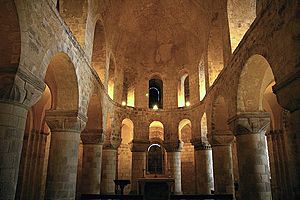
The round part in the south-east corner for St John's Chapel is very unusual for a castle. Only one other keep in England, Colchester Castle, has a similar design. St John's Chapel was not part of the White Tower's first plan. It was added after the basement walls were built.
Today, the chapel looks plain and simple, much like it would have looked in the Norman period. However, in the 1200s, during King Henry III's time, the chapel was beautifully decorated. It had a gold-painted cross and stained glass windows showing the Virgin Mary and the Holy Trinity.
See also
 In Spanish: Torre Blanca (Londres) para niños
In Spanish: Torre Blanca (Londres) para niños


